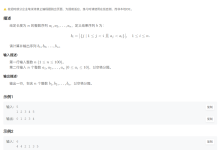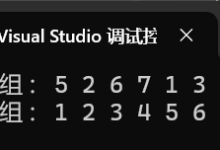unordered系列map和set,与普通区别
用法几乎相同,键值唯一,区别unordered系列迭代器是单向的并且遍历出来不是有序的。unordered系列在数据规模大且无序的情况下性能更优
底层实现:
map 和 set :基于平衡二叉树(通常是红黑树)实现,元素在树中按有序的方式存储。 unordered_map 和 unordered_set :基于哈希表实现,元素存储在哈希桶中,存储顺序与插入顺序无关。是通过哈希函数将键(或元素)映射到哈希表的桶索引
有序性:
map和set:有序,可按自定义排序规则 unordered:无序,存储顺序取决于哈希函数和哈希桶的分配。
适用场景
map 和 set :适用于需要元素有序的场景,如排序、范围查询等unordered_map 和 unordered_set :适用于需要快速插入和查找的场景,对元素的顺序没有要求。
1.哈希表改造
按照以下思路进行模拟实现 1、改装哈希表(哈希桶) 2、封装map和set 3、实现普通迭代器 4、实现const迭代器 5、解决insert返回值问题 实现operator[] 6、解决key不能修改的问题
节点定义
 用一个模板参数T来表示数据,unordered_set为key,map为pair<K,V>,实现了泛型。
用一个模板参数T来表示数据,unordered_set为key,map为pair<K,V>,实现了泛型。
1.2增加迭代器
基本模板
 总共有6个模板参数,K代表键值,T代表value值类型能实现map和set的泛型,Ptr是指针类型,Ref是引用类型,KeyOfT是用于从值中获取键值的函数,HashFunc是哈希函数将键值映射到地址上去 1.重定义一个self通用迭代器,模板参数为Ptr和Ref可以灵活地定义指针和引用类型,通常用于类的内部实现,引用或返回值。 2.重定义一个具体的迭代器iterator,其中指针类型和引用类型都被写死与T相同,是用于读写访问的迭代器,可以对容器中的元素进行修改。 3.需定义一个哈希表指针,因为自增操作时可以通过该指针方便遍历找到下一个哈希桶的位置。有如下作用:
总共有6个模板参数,K代表键值,T代表value值类型能实现map和set的泛型,Ptr是指针类型,Ref是引用类型,KeyOfT是用于从值中获取键值的函数,HashFunc是哈希函数将键值映射到地址上去 1.重定义一个self通用迭代器,模板参数为Ptr和Ref可以灵活地定义指针和引用类型,通常用于类的内部实现,引用或返回值。 2.重定义一个具体的迭代器iterator,其中指针类型和引用类型都被写死与T相同,是用于读写访问的迭代器,可以对容器中的元素进行修改。 3.需定义一个哈希表指针,因为自增操作时可以通过该指针方便遍历找到下一个哈希桶的位置。有如下作用:
a:提供对哈希表资源的访问。如哈希桶数组 _table、哈希函数 hf 和键提取函数 kot b: 封装哈希表的实现细节。使哈希表的内部实现可以在不改变迭代器代码的情况下进行修改。
构造函数
 1.将哈希表指针定义成const,因为在const迭代器begin和end函数中返回的this指针是const的,普通指针传进来也没问题,因为权限可以缩小不能放大,所以直接定义成const省略掉普通哈希表指针的迭代器构造 2.与set和map模拟实现中类似,一举两得,解决了返回值中非const的迭代器转化成const迭代器的过程。因为iterator的指针和引用参数写死了,就是常量。
1.将哈希表指针定义成const,因为在const迭代器begin和end函数中返回的this指针是const的,普通指针传进来也没问题,因为权限可以缩小不能放大,所以直接定义成const省略掉普通哈希表指针的迭代器构造 2.与set和map模拟实现中类似,一举两得,解决了返回值中非const的迭代器转化成const迭代器的过程。因为iterator的指针和引用参数写死了,就是常量。
自增++操作
self& operator++()
{
if (_node->_next)
{
//当前桶还没完,继续往下遍历
_node = _node->_next;
}
else
{
KeyOfT kot;
HashFunc hf;
size_t hashi = hf(kot(_node->_data)) % _pht->_table.size();
//从下一个位置寻找
hashi++;
while (hashi < _pht->_table.size())
{
if (_pht->_table[hashi])
{
_node = _pht->_table[hashi];
return *this;
}
else
{
hashi++;
}
}
//找完了没找到哈希桶
_node = nullptr;
}
return *this;
}
1.返回对当前迭代器对象的引用(self&),以便支持连续的自增操作 2.分当前桶中继续往下遍历和查找下一个哈希桶中两种情况 3.查找下一个哈希桶时先用获取键kot函数拿到键值然后用哈希函数hf计算该键的映射哈希值。从下一个哈希桶的位置开始找不为空的哈希桶,循环条件为哈希值索引小于当前已存储桶的大小,若找到不为空哈希桶返回this指针,没找到对当前_node置空再返回this指针
前置声明
 由于上图中存在相互包含问题,需要前置声明。 注意:编译器需要完整的类型定义来确定内存布局、调用成员函数和生成正确的机器码。前向声明只能用于指针和引用类型,因为这些类型不需要完整的类型信息。在需要直接实例化对象或调用成员函数时,必须包含完整的类型定义。 所以选择前向声明哈希表指针
由于上图中存在相互包含问题,需要前置声明。 注意:编译器需要完整的类型定义来确定内存布局、调用成员函数和生成正确的机器码。前向声明只能用于指针和引用类型,因为这些类型不需要完整的类型信息。在需要直接实例化对象或调用成员函数时,必须包含完整的类型定义。 所以选择前向声明哈希表指针
- 完整代码
//前置声明
template<class K, class T, class KeyOfT, class HashFunc>
class HashTable;
template<class K, class T, class Ptr, class Ref, class KeyOfT, class HashFunc>
struct HTIterator
{
typedef HashNode<T> Node;
typedef HTIterator<K, T,Ptr,Ref, KeyOfT, HashFunc> self;
typedef HTIterator<K, T, T*, T&, KeyOfT, HashFunc> iterator;
Node* _node;
const HashTable<K, T, KeyOfT, HashFunc>* _pht;
HTIterator(Node* node,const HashTable<K, T, KeyOfT, HashFunc>* pht)
:_node(node)
, _pht(pht)
{ }
// 普通迭代器时,他是拷贝构造
// const迭代器时,他是构造
HTIterator(const iterator& it)
:_node(it._node)
, _pht(it._pht)
{ }
Ref operator*()
{
return _node->_data;
}
Ptr operator->()
{
return &_node->_data;
}
self& operator++()
{
if (_node->_next)
{
//当前桶还没完,继续往下遍历
_node = _node->_next;
}
else
{
KeyOfT kot;
HashFunc hf;
size_t hashi = hf(kot(_node->_data)) % _pht->_table.size();
//从下一个位置寻找
hashi++;
while (hashi < _pht->_table.size())
{
if (_pht->_table[hashi])
{
_node = _pht->_table[hashi];
return *this;
}
else
{
hashi++;
}
}
//找完了没找到哈希桶
_node = nullptr;
}
return *this;
}
bool operator!=(const self& s)
{
return _node != s._node;
}
bool operator==(const self& s)
{
return _node == s._node;
}
};
1.3哈希表基本模板
 模板参数与模板重定义和迭代器的相同,注意要加上迭代器的友元声明,在迭代器中会访问哈希表中的私有变量
模板参数与模板重定义和迭代器的相同,注意要加上迭代器的友元声明,在迭代器中会访问哈希表中的私有变量
获取迭代器
iterator begin()
{
//找第一个桶
for (size_t i = 0; i < _table.size(); i++)
{
Node* cur = _table[i];
if (cur)
{
return iterator(cur, this);
}
}
return iterator(nullptr, this);
}
iterator end()
{
return iterator(nullptr, this);
}
const_iterator begin()const
{
//找第一个桶
for (size_t i = 0; i < _table.size(); i++)
{
Node* cur = _table[i];
if (cur)
{
return const_iterator(cur, this);
}
}
return const_iterator(nullptr, this);
}
const_iterator end()const
{
return const_iterator(nullptr, this);
}
注意迭代器是由当前节点和哈希表指针构成,末尾迭代器返回空指针和this指针。
构造与析构函数
HashTable()
{
_table.resize(10, nullptr);
}
~HashTable()
{
for (size_t i = 0; i < _table.size(); i++)
{
Node* cur = _table[i];
while (cur)
{
Node* next = cur->_next;
delete cur;
cur = next;
}
_table[i] = nullptr;
}
}
resize开辟和初始化空间为空,由于vector数组中每个位置都存储着链表头指针,自定义类型需要手动释放空间
插入
pair<iterator,bool> Insert(const T&data)
{
KeyOfT kot;
iterator it=Find(kot(data));
if(it!=end())
{
return make_pair(it,false);
}
HashFunc hf;
//检查扩容,载荷因子到1就扩容
if (_n == _table.size())
{
size_t newsize = _table.size() * 2;
vector<Node*> newtable;
newtable.resize(newsize, nullptr);
//遍历旧表,将节点转移挂到新表
for (size_t i = 0; i < _table.size(); i++)
{
Node* cur = _table[i];
//在数组中向下遍历处理每一个哈希桶
while (cur)
{
size_t hashi = hf(kot(data)) % newsize;
Node* next = cur->_next;
//头插
cur->_next = newtable[hashi];
newtable[hashi] = cur;
//更新节点
cur = next;
}
_table[i] = nullptr;
}
//交换新旧表
_table.swap(newtable);
}
//插入新节点
size_t hashi = hf(kot(data)) % _table.size();
Node* newnode = new Node(data);
newnode->_next = _table[hashi];
_table[hashi] = newnode;
++_n;
return make_pair(iterator(newnode,this),true);
}
1.创建一个提取键对象,可以像函数一样调用 2.检查待插入元素是否已存在 3.定义一个哈希函数对象,重载了()也可以像函数一样被调用 4.检查扩容,与原哈希表逻辑相同 5.重新计算哈希值再创建新节点并插入,更新有效值元素,返回一个由迭代器和bool值构成的键值对
由于unordered_map的[]重载需要通过insert实现,需要提供对指定键的值的访问,如果键不存在,则需要插入一个默认构造的值。所以insert的返回值要变成键值对
查找
iterator Find(const K& key)
{
KeyOfT kot;
HashFunc hf;
size_t hashi = hf(key) % _table.size();
//在该哈希桶中遍历寻找
Node* cur = _table[hashi];
while (cur)
{
if (kot(cur->_data) == key)
{
return iterator(cur,this);
}
cur = cur->_next;
}
return end();
}
与原哈希表区别在于返回值变成迭代器
删除
bool Erase(const K& key)
{
HashFunc hf;
size_t hashi = hf(key) % _table.size();
Node* cur = _table[hashi];
Node* prev = nullptr;
while (cur)
{
if (kot(cur->_data) == key)
{
//判断要删除节点为头节点情况
if (prev == nullptr)
{
_table[hashi] = cur->_next;
}
else
{
prev->_next = cur->_next;
}
—_n;
delete cur;
return true;
}
//更新节点继续遍历
prev = cur;
cur = cur->_next;
}
return false;
}
与原哈希表相同
哈希函数
template<class K>
struct DefaultHashFunc
{
size_t operator()(const K& key)
{
//强转成返回值类型
return (size_t)key;
}
};
//模板特化
template<>
struct DefaultHashFunc<string>
{
size_t operator()(const string& str)
{
// BKDR,string的哈希算法
size_t hash = 0;
for (auto ch : str)
{
hash *= 131;
hash += ch;
}
return hash;
}
};
与原哈希表相同
- 代码
template<class K>
struct DefaultHashFunc
{
size_t operator()(const K& key)
{
//强转成返回值类型
return (size_t)key;
}
};
//模板特化
template<>
struct DefaultHashFunc<string>
{
size_t operator()(const string& str)
{
// BKDR,string的哈希算法
size_t hash = 0;
for (auto ch : str)
{
hash *= 131;
hash += ch;
}
return hash;
}
};
namespace hash_bucket
{
template<class T>
struct HashNode
{
T _data;
HashNode<T>* _next;
HashNode(const T&data)
:_data(data)
, _next(nullptr)
{
}
};
//前置声明
template<class K, class T, class KeyOfT, class HashFunc>
class HashTable;
template<class K, class T, class Ptr, class Ref, class KeyOfT, class HashFunc>
struct HTIterator
{
typedef HashNode<T> Node;
typedef HTIterator<K, T,Ptr,Ref, KeyOfT, HashFunc> self;
typedef HTIterator<K, T, T*, T&, KeyOfT, HashFunc> iterator;
Node* _node;
const HashTable<K, T, KeyOfT, HashFunc>* _pht;
HTIterator(Node* node,const HashTable<K, T, KeyOfT, HashFunc>* pht)
:_node(node)
, _pht(pht)
{ }
// 普通迭代器时,他是拷贝构造
// const迭代器时,他是构造
HTIterator(const iterator& it)
:_node(it._node)
, _pht(it._pht)
{ }
Ref operator*()
{
return _node->_data;
}
Ptr operator->()
{
return &_node->_data;
}
self& operator++()
{
if (_node->_next)
{
//当前桶还没完,继续往下遍历
_node = _node->_next;
}
else
{
KeyOfT kot;
HashFunc hf;
size_t hashi = hf(kot(_node->_data)) % _pht->_table.size();
//从下一个位置寻找
hashi++;
while (hashi < _pht->_table.size())
{
if (_pht->_table[hashi])
{
_node = _pht->_table[hashi];
return *this;
}
else
{
hashi++;
}
}
//找完了没找到哈希桶
_node = nullptr;
}
return *this;
}
bool operator!=(const self& s)
{
return _node != s._node;
}
bool operator==(const self& s)
{
return _node == s._node;
}
};
// set -> hash_bucket::HashTable<K, K> _ht;
// map -> hash_bucket::HashTable<K, pair<K, V>> _ht;
template<class K, class T,class KeyOfT, class HashFunc = DefaultHashFunc<K>>
class HashTable
{
typedef HashNode<T> Node;
//友元声明
template<class K, class T,class Ptr,class Ref, class KeyOfT, class HashFunc>
friend struct HTIterator;
public:
typedef HTIterator<K, T,T*,T&, KeyOfT, HashFunc> iterator;
typedef HTIterator<K, T,const T*,const T&, KeyOfT, HashFunc> const_iterator;
iterator begin()
{
//找第一个桶
for (size_t i = 0; i < _table.size(); i++)
{
Node* cur = _table[i];
if (cur)
{
return iterator(cur, this);
}
}
return iterator(nullptr, this);
}
iterator end()
{
return iterator(nullptr, this);
}
const_iterator begin()const
{
//找第一个桶
for (size_t i = 0; i < _table.size(); i++)
{
Node* cur = _table[i];
if (cur)
{
return const_iterator(cur, this);
}
}
return const_iterator(nullptr, this);
}
const_iterator end()const
{
return const_iterator(nullptr, this);
}
HashTable()
{
_table.resize(10, nullptr);
}
~HashTable()
{
for (size_t i = 0; i < _table.size(); i++)
{
Node* cur = _table[i];
while (cur)
{
Node* next = cur->_next;
delete cur;
cur = next;
}
_table[i] = nullptr;
}
}
pair<iterator,bool> Insert(const T&data)
{
KeyOfT kot;
iterator it=Find(kot(data));
if(it!=end())
{
return make_pair(it,false);
}
HashFunc hf;
//检查扩容,载荷因子到1就扩容
if (_n == _table.size())
{
size_t newsize = _table.size() * 2;
vector<Node*> newtable;
newtable.resize(newsize, nullptr);
//遍历旧表,将节点转移挂到新表
for (size_t i = 0; i < _table.size(); i++)
{
Node* cur = _table[i];
//在数组中向下遍历处理每一个哈希桶
while (cur)
{
size_t hashi = hf(kot(data)) % newsize;
Node* next = cur->_next;
//头插
cur->_next = newtable[hashi];
newtable[hashi] = cur;
//更新节点
cur = next;
}
_table[i] = nullptr;
}
//交换新旧表
_table.swap(newtable);
}
//插入新节点
size_t hashi = hf(kot(data)) % _table.size();
Node* newnode = new Node(data);
newnode->_next = _table[hashi];
_table[hashi] = newnode;
++_n;
return make_pair(iterator(newnode,this),true);
}
iterator Find(const K& key)
{
KeyOfT kot;
HashFunc hf;
size_t hashi = hf(key) % _table.size();
//在该哈希桶中遍历寻找
Node* cur = _table[hashi];
while (cur)
{
if (kot(cur->_data) == key)
{
return iterator(cur,this);
}
cur = cur->_next;
}
return end();
}
bool Erase(const K& key)
{
HashFunc hf;
size_t hashi = hf(key) % _table.size();
Node* cur = _table[hashi];
Node* prev = nullptr;
while (cur)
{
if (kot(cur->_data) == key)
{
//判断要删除节点为头节点情况
if (prev == nullptr)
{
_table[hashi] = cur->_next;
}
else
{
prev->_next = cur->_next;
}
—_n;
delete cur;
return true;
}
//更新节点继续遍历
prev = cur;
cur = cur->_next;
}
return false;
}
void Print()
{
for (size_t i = 0; i < _table.size(); i++)
{
printf("[%d]->", i);
Node* cur = _table[i];
while (cur)
{
cout << cur->_kv.first << ":" << cur->_kv.second << "->";
cur = cur->_next;
}
printf("NULL\\n");
}
cout << endl;
}
private:
vector<Node*> _table;//指针数组
size_t _n = 0;
};
}
- 测试代码
#include<iostream>
using namespace std;
#include"HashTable.h"
#include"UnOrderedSet.h"
#include"UnOrderedMap.h"
int main()
{
ee::unordered_set<int> us;
us.insert(3);
us.insert(1);
us.insert(3);
us.insert(4);
us.insert(5);
us.insert(0);
ee::unordered_set<int>::iterator it = us.begin();
while (it != us.end())
{
//*it += 10;不能修改key
cout << *it << " ";
++it;
}
cout << endl;
ee::unordered_map<string, string> dict;
dict.insert(make_pair("sort", "排序"));
dict.insert(make_pair("left", "左边"));
dict.insert(make_pair("insert", "插入"));
dict.insert(make_pair("sort", "xxx"));
ee::unordered_map<string, string>::iterator dit = dict.begin();
while (dit != dict.end())
{
//不能修改key
//dit->first += 'e';
dit->second += 'e';
cout << dit->first << ":" << dit->second << endl;
++dit;
}
dict["sort"] = "排序";
dict["insert"] = "插入";
dict["string"] = "字符串";
dict["left"];
for (auto& kv : dict)
{
cout << kv.first << ":" << kv.second << endl;
}
return 0;
}
2.封装unordered_set
#pragma once
namespace ee
{
template<class K>
struct unordered_set
{
struct SetKeyOfT
{
const K& operator()(const K& key)
{
return key;
}
};
public:
typedef typename hash_bucket::HashTable<K, K, SetKeyOfT>::const_iterator iterator;
typedef typename hash_bucket::HashTable<K, K, SetKeyOfT>::const_iterator const_iterator;
//迭代器底层都是const,直接定义成const即可
const_iterator begin()const
{
return _ht.begin();
}
const_iterator end()const
{
return _ht.end();
}
pair<const_iterator,bool> insert(const K& key)
{
//return _ht.Insert(key);编译器严格检查下可能报错
pair<typename hash_bucket::HashTable<K, K, SetKeyOfT>::iterator, bool> ret = _ht.Insert(key);
return pair<const_iterator, bool>(ret.first, ret.second);
}
private:
hash_bucket::HashTable<K, K, SetKeyOfT> _ht;
};
}
迭代器底层都是const_iterator(确保键值不能修改),会造成返回值类型不匹配,与map和set的模拟实现一样,这里解决办法相同,先用哈希表中迭代器接收插入后的返回值普通迭代器,利用在哈希表中写的支持非const转化为const迭代器的函数来构造出const迭代器并返回。
3.封装unordered_map
#pragma once
namespace ee
{
template<class K,class V>
struct unordered_map
{
struct MapKeyOfT
{
const K& operator()(const pair<K,V>& kv)
{
return kv.first;
}
};
public:
typedef typename hash_bucket::HashTable<K, pair<const K,V>, MapKeyOfT>::iterator iterator;
typedef typename hash_bucket::HashTable<K, pair<const K, V>, MapKeyOfT>::const_iterator const_iterator;
iterator begin()
{
return _ht.begin();
}
iterator end()
{
return _ht.end();
}
const_iterator begin()const
{
return _ht.begin();
}
const_iterator end()const
{
return _ht.end();
}
pair<iterator,bool> insert(const pair<K,V>& kv)
{
return _ht.Insert(kv);
}
V& operator[](const K&key)
{
pair<iterator, bool> ret = _ht.Insert(make_pair(key, V()));
return ret.first->second;
}
private:
hash_bucket::HashTable<K, pair<const K,V>, MapKeyOfT> _ht;
};
}
这里插入就不会有set的迭代器返回值类型不匹配的问题,常量迭代器和普通迭代器底层就是其本身。 []重载: 返回值 :返回类型为 V&,即键对应的值的引用。如果键不存在,则插入一个默认构造的值并返回其引用。 Insert 方法 :尝试将键值对插入哈希表。如果键已存在,Insert 返回一个 pair,其中迭代器指向已存在的键值对,bool 值为 false;如果键不存在,Insert 插入键值对并返回一个 pair,其中迭代器指向新插入的键值对,bool 值为 true。 返回值引用 :ret.first->second 返回键值对中值的引用。无论键是否已存在,都能通过这个引用访问或修改值。
 网硕互联帮助中心
网硕互联帮助中心



![[TG开发]简单的回声机器人-网硕互联帮助中心](https://www.wsisp.com/helps/wp-content/uploads/2025/08/20250816114512-68a06f48800c8-220x150.png)

评论前必须登录!
注册